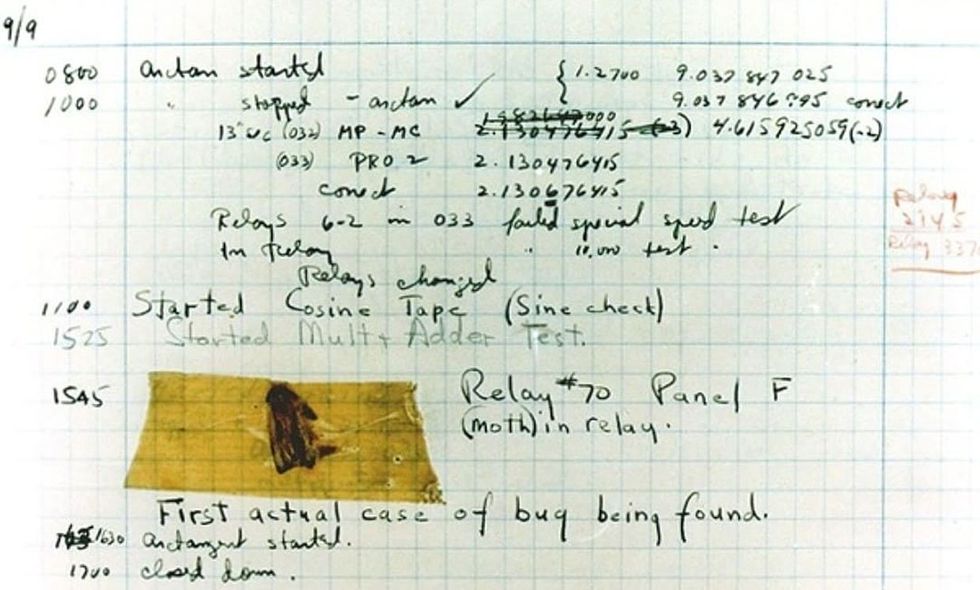Another in a series of articles that uncover interesting historical, technical, and IEEE-related topics.
Ask someone to identify the first computer bug, and he or she might mention computer programmer Grace Hopper and the dead moth found in a relay of Harvard University’s Mark II electromechanical computer in 1947. After a technician found the moth, Hopper and her staff used the word “bug” to describe the issues that complicated the input of data and the writing, loading, and processing of programs in their Mark I and II computers.
But Hopper’s bug was not a new term or simply a variant of a “fly in the ointment.” The use of “bug” to describe a flaw in the design or operation of a technical system dates back to Thomas Edison. He coined the phrase 140 years ago to describe technical problems during the process of innovation.

MANGLED MESSAGES
In 1873 Edison first confronted what he later called a bug when he began developing a quadruplex telegraph system to transmit and receive up to four separate telegrams on a single wire simultaneously. If he succeeded, his patron, Western Union Telegraph, would profit greatly from the increased message capacity. The 26-year-old engineer combined diplex and duplex circuits to send two messages in each direction using changes in current direction and strength. The problem in this approach was the false break in a message’s signal created by the changing polarity of the electromagnet in the diplex circuit when the current switched direction.
Edison worked around this by building what he later called a “bug trap” to isolate the unwanted break so that it wouldn’t interfere with the meaning of the Morse-coded signal. In August 1873 he filed a patent caveat, a form of patent application long since discontinued, which included this solution. A year later it became part of his application for U.S. Patent 480,567, which did not issue until 1892 due to patent-interference claims and court cases.
SPREADING THE WORD
Edison is largely responsible for broadening the term’s application. The term itself appeared in his notebooks in 1876, first occurring that July in connection with his experiments on another approach to multiplexing signals over a wire. A later Edison biography made note of its frequent appearance in his notebooks. One entry, referring to incandescent lighting, read: “Awful lot of bugs still. Let [Dr. Otto] Moses try…to rid us of them.”
By 1878, Edison was also using the term to describe technical problems to associates outside of the laboratory. In March he joked in a letter to Western Union President William Orton:
“You were partly correct, I did find a ‘bug’ in my apparatus, but it was not in the telephone proper. It was of the genus ‘callbellum.’ The insect appears to find conditions for its existence in all call apparatus of Telephones.”
And in November of that year he wrote to Thedore Puskas about what happens after conceiving an invention, when difficulties arise and the unexpected occurs: “This thing gives out and then that. ‘Bug’—as such little faults and difficulties are called—show themselves, and months of anxious watching, study, and labor are requisite before commercial success—or failure—is certainly reached.”
Edison’s propensity for staying up all night to perfect and debug his inventions caught the attention of numerous reporters, some of whom reported his use of the term. In 1889 the reporter for a British newspaper wrote, “Mr. Edison…had been up the two previous nights working on fixing ‘a bug’ in his phonograph—an expression for solving a difficulty, and implying that some imaginary insect has secreted itself inside and is causing all the trouble.” And in a 1916 article about Edison’s “insomnia squad,” a reporter noted that they worked “like fiends when they [were] ‘fishing for a bug.’ That means that they are searching for some missing quality, quantity, or combination that will add something toward the perfect whole.”
The term was also spread by members of the electrical community. By the mid-1880s, after the quadruplex had become a common feature of telegraphy, engineers made frequent reference to Edison’s bug trap. And in 1888, William Maver, who later wrote the standard book on American telegraphy, noted that those familiar with the quadruplex were “aware that there is tendency in its operation termed, not very elegantly perhaps, the ‘bug.' It was first so called by Edison.”

Author and engineer Thomas Sloane standardized Edison’s terms in his 1892 Standard Electrical Dictionary. He defined a bug as “[a]ny fault or trouble in the connections or working of electric apparatus,” with a bug trap being a “connection or arrangement for overcoming” said bug. Both terms, “[i]t is said […] originated in quadruplex telegraphy.” Funk and March’s 1895 Standard Dictionary of the English Language gave the term to the general public as “a fault in the working of a quadruplex system or in any electrical apparatus.”
By the early 1900s the idea of bugs and bug traps had gone well beyond Edison and his inventions. The International Correspondence Schools’ 1913 Elements of Telegraph Operating referred to the “bug-trap remedy” as one of several solutions for eliminating “slight disturbances” in a circuit. In 1921, Transactions of the American Institute of Electrical Engineers included a lengthy paper on railroad telegraphy and telephony in which bug traps were the subject of considerable discussion.
News of Edison’s quadruplex also encouraged German speakers to adopt the terms “bug” and “bug trap” in translation. Karl Zetzsche explained in his 1890 Handbuch der Electrischen Telegraphie (Handbook of Electrical Telegraphy) that Edison used “neutralen und einem polarisirten Relais in Brückenschaltung und mit Wanzenfalle in Thätigkeit,” or “neutral and polarized relays in a bridge circuit with a bug trap during action.” Three years later, Dinglers Polytechnisches Journal also referred to “Edison’s Wanzen Falle (bug trap).”
Grace Hopper did not invent the bug, but she did draw cartoons of gremlins that represented chads, or fragments, created when holes are made in her computer’s punched paper tapes. Like Edison, she was recalling the word’s older origins in the Welsh bwg, the Scottish bogill or bogle, the German bögge, and the Middle English bugge: the hobgoblins of pre-modern life, resurrected in the 19th century as, to paraphrase philosopher Gilbert Ryle, ghosts in the machine. Bugs are not only for today’s computers or software; for more than 100 years, they have represented the challenges of an imperfect world that engineers work to overcome.
Alexander Magoun is an outreach historian with the IEEE History Center. Paul Israel is director and general editor of the Edison Papers—a collection of Thomas Edison’s writings, drawings, and business papers—at Rutgers University, in New Brunswick, N.J.
The IEEE History Center, which contributed this article, is funded by donations from institutions and individuals.
